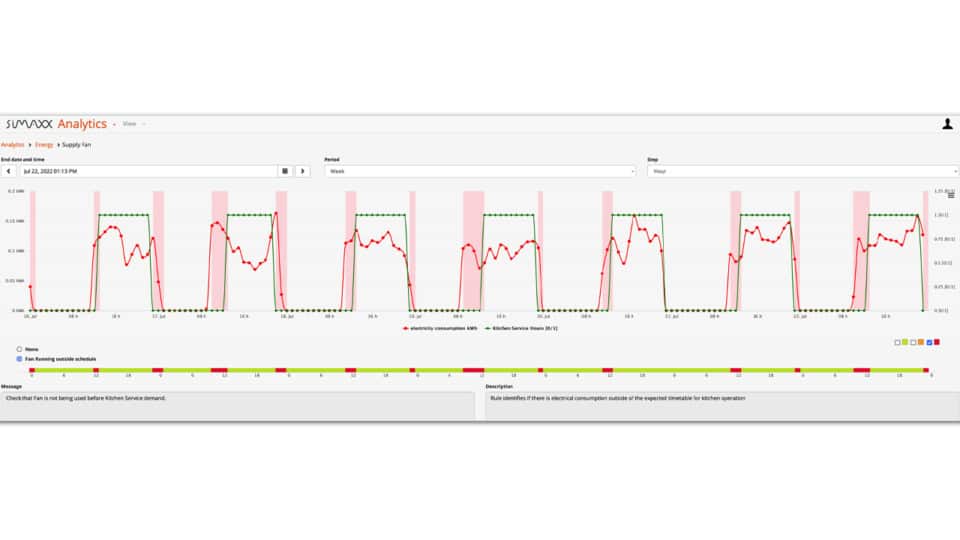Legionella monitoring
Proper Legionella monitoring procedures are important for avoiding dangers of fatal cases of Legionnaires’ disease, implementing effective Legionella control measures can be the best way to ensure that your water systems are safe to use.
Breathe in. Breathe out.
Legionella tends to cause Legionnaires’ Disease, a fatal type of pneumonia. Bacteria is commonly found in water, multiplying at temperatures between 20-45 °C. If inhaled through airborne water droplets created by water systems.
Step 3
Data Capture
Hot Water System temperatures and occupancy schedules can be captured from a site Building Management System or IoT wireless solution.
Step 4
Compliance Monitor
Simaxx automated analytic rules are based around ACOP L8 requirements for Legionella Monitoring and create email alerts when the system falls outside guideline requirements. This ensures that data is being evaluated continuously and corrective action requirements are highlighted.
Step 6
Report Templates
Report on outcomes of legionella reporting. Provide weekly, and monthly reports for Governance. Easy to output from stored templates.
Legal requirement
By monitoring air quality, the platform contributes to maintaining a healthy indoor environment, reducing the risk of respiratory issues and other health concerns associated with poor air quality. Studies have shown that improved air quality can enhance cognitive performance and productivity, making air quality monitoring a valuable tool for optimising workplace environments.
Automatic monitoring
Automatic monitoring offer more effective ways of gathering information about pollutant levels, allowing you to collect data every hour without needing to actively monitor the situation.

Case study 1
Aquaportal
Step 2
Real-time monitoring
Tyrrell Analytics platform continuously monitor air quality in real-time, providing up-to-the-hour data on pollutant levels and environmental conditions
Estimation & prediction
By shifting all of IAQ data into one central location, it becomes much easier to analyse everything you have monitored, using that information to build forecasts and find likely causes of particulate matter pollution.
Simaxx provides an easy way to gather information and predict long-term trends for your total air pollution levels, letting you estimate future control effectiveness based on the emissions you have already produced.
While it is still best to use hard data whenever possible, looking into long-term trends and personal predictions for your pollutant levels is important. Pollution forecasts can provide valuable insight into your long-term air quality and give you a baseline for how your pollutant levels may increase if left unchecked.

Reporting and analytics
Centralised location for all data
By shifting all of IAQ data into one central location, it becomes much easier to analyse everything you have monitored, using that information to build forecasts and find likely causes of particulate matter pollution.
Customisable reports
Users can generate reports summarising air quality metrics and trends, which can be useful for internal assessments and communication with stakeholders.
Historic data
Having easy access to so much historical data allows you to achieve full monitoring of your energy performance. You can use your entire energy efficiency history to form baselines and figure out expected results, using any point of data you need without the worry of it being lost or corrupted.

Solution
Tyrrell Analytics air quality monitoring solution leverage sensor technology and data analytics to ensure that indoor environments are healthy, comfortable, and conducive to productivity. Solution plays a vital role in creating intelligent and responsive building ecosystems that prioritise the well-being of occupants.
It appears on both residential and commercial properties.
Controlling Legionella Bacteria
Putting the right Legionella control measures in place is important for keeping your water systems clear of Legionella.
Temperature Control
The main method used to control Legionella levels and prevent Legionella growth is through temperature control. Like most bacteria in water handling systems, Legionella requires specific conditions to grow well, and disrupting its natural environment can help a lot.
Legionella risk assessments are a legal requirement under the Health and Safety at Work Act 1974. Building managers are required, by health and safety law, to perform a Legionella risk assessment whenever necessary.
The person who works under the regulations of the Legionella Control Association to audit the situation and ensure compliance.
Simaxx provides the monitoring to mitigate Legionella risks and provides rules in line with ACOP L8, as well as providing a vast range of monitoring and reporting tools that can fit with any business.
By handing off responsibility to these services – which is allowed – a safety specialist can ensure that all of the right services and methods are employed quickly and effectively. The risk of Legionnaires’ Disease spreading to cooling towers and other cold-water appliances can sometimes be too great to ignore.
Using these services also means that you are not personally required to handle every step of the project, something that can take a long time in larger properties. Office buildings routinely hand off their control options to third-party services specifically because of the huge workload involved.

Leaving your system untested and untreated can be a massive health and safety risk. The disease will impact people of any health and specifically target those already in poor health, meaning that nobody will be safe until you clear up your system.
Simaxx improves the reporting accuracy and risk assessments of legionella control in hot water systems. The automated rules and report templates eliminate labour-intensive processes.
